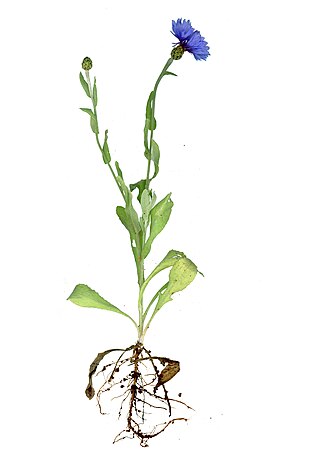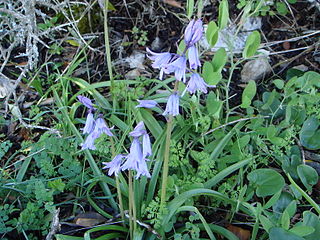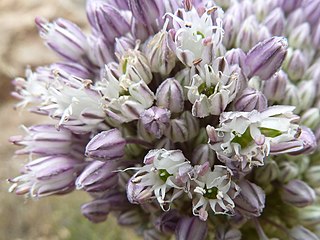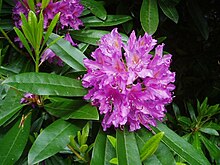
Eschscholzia californica, the California poppy, golden poppy, California sunlight or cup of gold, is a species of flowering plant in the family Papaveraceae, native to the United States and Mexico. It is cultivated as an ornamental plant flowering in summer, with showy cup-shaped flowers in brilliant shades of red, orange and yellow. It is also used as food or a garnish. It became the official state flower of California in 1903.

Sorghum or broomcorn is a genus of about 25 species of flowering plants in the grass family (Poaceae). Some of these species are grown as cereals for human consumption, in pastures for animals as fodder, and as bristles for brooms. Sorghum grain is a nutritious food rich in protein, dietary fiber, B vitamins, and minerals.

Acorus is a genus of monocot flowering plants. This genus was once placed within the family Araceae (aroids), but more recent classifications place it in its own family Acoraceae and order Acorales, of which it is the sole genus of the oldest surviving line of monocots. Some older studies indicated that it was placed in a lineage, that also includes aroids (Araceae), Tofieldiaceae, and several families of aquatic monocots. However, modern phylogenetic studies demonstrate that Acorus is sister to all other monocots. Common names include calamus and sweet flag.

Acer pseudoplatanus, known as the sycamore in the British Isles and as the sycamore maple in the United States, is a species of flowering plant in the soapberry and lychee family Sapindaceae. It is a large deciduous, broad-leaved tree, tolerant of wind and coastal exposure. It is native to Central Europe and Western Asia, from France eastward to Ukraine, northern Turkey and the Caucasus and southward in the mountains of Italy and northern Iberia.

Dioscorea alata – also called purple yam, ube, or greater yam, among many other names – is a species of yam. The tubers are usually a vivid violet-purple to bright lavender in color, but some range in color from cream to plain white. It is sometimes confused with taro and the Okinawa sweet potato beniimo (紅芋), however D. alata is also grown in Okinawa. With its origins in the Asian tropics, D. alata has been known to humans since ancient times.

Centaurea cyanus, commonly known as cornflower or bachelor's button, is an annual flowering plant in the family Asteraceae native to Europe. In the past, it often grew as a weed in cornfields, hence its name. It is now endangered in its native habitat by agricultural intensification, particularly by over-use of herbicides. However, Centaurea cyanus is now also naturalised in many other parts of the world, including North America and parts of Australia through introduction as an ornamental plant in gardens and as a seed contaminant in crop seeds.

A wildflower is a flower that grows in the wild, meaning it was not intentionally seeded or planted. The term implies that the plant is neither a hybrid nor a selected cultivar that is any different from the native plant, even if it is growing where it would not naturally be found. The term can refer to the whole plant, even when not in bloom, and not just the flower.

Hyacinthoides hispanica, the Spanish bluebell, is a spring-flowering bulbous perennial native to the Iberian Peninsula. It is one of around a dozen species in the genus Hyacinthoides, others including the common bluebell in northwestern Europe, and the Italian bluebell further east in the Mediterranean region.

A synanthrope is an organism that lives near and benefits from humans and their environmental modifications. The term synanthrope includes many species regarded as pests or weeds, but does not include domesticated animals. Common synanthrope habitats include houses, gardens, farms, parks, roadsides and rubbish dumps.

Capsella bursa-pastoris, known as shepherd's purse because of its triangular flat fruits, which are purse-like, is a small annual and ruderal flowering plant in the mustard family (Brassicaceae). It is native to eastern Europe and Asia minor, but is naturalized and considered a common weed in many parts of the world, especially in colder climates, including British Isles, where it is regarded as an archaeophyte, North America and China, but also in the Mediterranean and North Africa. C. bursa-pastoris is the second-most prolific wild plant in the world, and is common on cultivated ground and waysides and meadows.

Allium ampeloprasum is a member of the onion genus Allium. The wild plant is commonly known as wild leek or broadleaf wild leek. Its native range is southern Europe to southwestern Asia and North Africa, but it is cultivated in many other places and has become naturalized in many countries.

Roystonea is a genus of eleven species of monoecious palms, native to the Neotropics, in the Caribbean, the adjacent coasts of Florida in the United States, Mexico, Central America and northern South America. Commonly known as the royal palms, the genus was named after Roy Stone, a U.S. Army engineer. It contains some of the most recognizable and commonly cultivated palms of tropical and subtropical regions.

The genus Tacca, which includes the batflowers and arrowroot, consists of flowering plants in the order Dioscoreales, native to tropical regions of South America, Africa, Australia, Southeast Asia, and various Oceanic islands. In older texts, the genus was treated in its own family Taccaceae, but the 2003 APG II system incorporates it into the family Dioscoreaceae. The APG III and APG IV systems continue to include Tacca in Dioscoreaceae.

Lathyrus aphaca, known as the yellow pea or yellow vetchling, is an annual species in the family Fabaceae with yellow flowers and solitary, pea-like fruits. It originated in the Middle East and has spread throughout Europe and beyond as a weed of cultivated fields and roadsides. The fruits are eaten as a supplement to diets in some parts of South Asia but are narcotic and potentially toxic in large quantities.

Roemeria argemone is a species of flowering plant in the poppy family Papaveraceae. Its common names include long pricklyhead poppy, prickly poppy and pale poppy. Its native range includes parts of Eurasia and North Africa, but it can be found growing wild in parts of North America, where it is an introduced species. It is cultivated as an ornamental plant.

In botany, a neophyte is a plant species which is not native to a geographical region and was introduced in recent history. Non-native plants that are long-established in an area are called archaeophytes. In Britain, neophytes are defined more specifically as plant species that were introduced after 1492, when Christopher Columbus arrived in the New World and the Columbian Exchange began.

Setaria palmifolia is a species of grass known by the common names palmgrass, highland pitpit, hailans pitpit, short pitpit, broadleaved bristlegrass, and knotroot. In Spanish it is called pasto de palma and in Samoan vao 'ofe 'ofe. It is native to temperate and tropical Asia. It is known elsewhere as an introduced, and often invasive, species, including in Australia, New Zealand, many Pacific Islands, and the Americas.

Escaped plants are cultivated plants, usually garden plants, that are not originally native to an area, and due to their dispersal strategies, have escaped from cultivation and have settled in the wild and bred there, whether intentionally or unintentionally. Escaped plants are purposefully introduced plants that have naturalized in the wild and can develop into invasive plants, the settlement of which is to be assessed as problematic. Other commonly used terms include escaped garden plant, garden escapee, escaped ornamental or garden refugee.

Hemerochory is the distribution of cultivated plants or their seeds and cuttings, consciously or unconsciously, by humans into an area that they could not colonize through their natural mechanisms of spread, but are able to maintain themselves without specific human help in their new habitat.

Adventive plants or adventitious plants are plants that have established themselves in a place that does not correspond to their area of origin due to anthropogenic influence and, therefore, are all wild species that have only been established with the help of humans, in contrast to the native species.





















